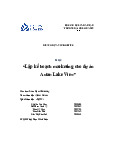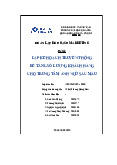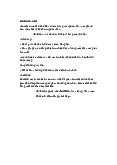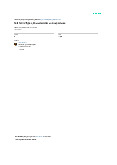








Preview text:
Sample Exam Question: 30 Marks
Henry owns an Italian restaurant. He has several employees working in the kitchen and delivering pizzas.
Genny is employed by Henry as his store manager and she was given an interest free loan
of $500,000 by Henry on 1 April 2019. Genny used the loan for two purposes: 60% for the
purchase of an investment property and 40% to pay off her home mortgage.
Earlier, in January 2020, Henry purchased an office building for $1,000,000. He was able to
receive $100,000 in rent per annum. On 30 June 2020 he sold the office building for
$1,500,000. The costs he incurred on the purchase were $10,000 for the legal expenses
and $40,000 Stamp duty. The costs he incurred on the sale were $30,000 for real estate
agent’s commission $5,000 for legal expenses and $2,000 for advertising.
His ownership costs over the period were $305,000.
Henry purchased a diamond necklace for $1,00 in June 2000 and sold it in June 2020 for $12,000. Required: Part a (10 marks)
What is the Fringe Benefits Tax payable by Henry on the Fringe Benefits he has
provided to Genny for the year ended 31 March 2020? Part b (10 marks)
What is Henry’s statutory income (that is the net Capital Gain) in relation to the sale of
the office building for the year ended 30 June 2020? Part c (10 marks)
What is Henry’s statutory income (that is the net Capital Gain) in relation to the sale of
the the diamond necklace for the year ended 30 June 2020?
You must give reasons for your answer. Your discussion must include an analysis of the
pertinent sections of the relevant legislation, rulings, and the relevant case law.
Where relevant, you must show your calculations.
You must apply the law to the facts and provide YOUR OWN analysis of the issues and
write a comprehensive answer to the question Answer: dentified type of benefit is loan fringe benefit (Sec 16) where a person (employer) makes a loan to another person (employee) and charges an interest rate is either low or interest free. The low rate interest are generally lower than the statutory rate which is a benchmark interest rate published by the ATO. No exemptions identified. The statutory interest rate is 5.37% for the year end 30 June 2020 The taxable value is calculated as follows: = [500000 – (60%x 500000) x 5.37%] = 10740 Grossed-up Taxable Value: GST does not affect the taxable value of loan fringe benefit, so these benefits as always grossed up at the type 2 rate (1.8868) Grossed-up Taxable Value = Taxable Value X Grossed-Up Rate = 10740 x 1.8868 =20264.232 Fringe Benefit Tax = Grossed-up Taxable Value x Fringe Benefit Tax Rate 20264.232 x 47% =9524.19 FBT payable is 9524.19 Capital proceedings: 1,500,000 Cost Base: Acquisition cost: 1,000,000 Incidental cost (10,000+30,000+40,000+ 5,000+2,000)= 87,000 dentified type of benefit is loan fringe benefit (Sec 16) where a person (employer) makes a loan to another person (employee) and charges an interest rate is either low or interest free. The low rate interest are generally lower than the statutory rate which is a benchmark interest rate published by the ATO. No exemptions identified. The statutory interest rate is 5.37% for the year end 30 June 2020 The taxable value is calculated as follows: = [500000 – (60%x 500000) x 5.37%] = 10740 Grossed-up Taxable Value: GST does not affect the taxable value of loan fringe benefit, so these benefits as always grossed up at the type 2 rate (1.8868) Grossed-up Taxable Value = Taxable Value X Grossed-Up Rate = 10740 x 1.8868 =20264.232 Fringe Benefit Tax = Grossed-up Taxable Value x Fringe Benefit Tax Rate 20264.232 x 47% =9524.19 FBT payable is 9524.19 Capital proceedings: 1,500,000 Cost Base: Acquisition cost: 1,000,000 Incidental cost (10,000+30,000+40,000+ 5,000+2,000)= 87,000
identified type of benefit is loan fringe benefit (Sec 16) where a person (employer) makes a loan to
another person (employee) and charges an interest rate is either low or interest free. The low rate
interest are generally lower than the statutory rate which is a benchmark interest rate published by the ATO. No exemptions identified.
The statutory interest rate is 5.37% for the year end 30 June 2020
The taxable value is calculated as follows:
= [500000 – (60%x 500000) x 5.37%] = 10740 Grossed-up Taxable Value:
GST does not affect the taxable value of loan fringe benefit, so these benefits as always grossed up at the type 2 rate (1.8868)
Grossed-up Taxable Value = Taxable Value X Grossed-Up Rate = 10740 x 1.8868 =20264.232
Fringe Benefit Tax = Grossed-up Taxable Value x Fringe Benefit Tax Rate 20264.232 x 47% =9524.19 FBT payable is 9524.19 Capital proceedings: 1,500,000 Cost Base: Acquisition cost: 1,000,000 Incidental cost
(10,000+30,000+40,000+5,000+2,000)= 87,000 Element 4: Capital cost incurred to increase or preserve the value of the asset Element 5: Capital cost of preserving or defending the title or rights to the CGT asset.
Element 4: Capital cost incurred to increase or preserve the value of the asset
Element 5: Capital cost of preserving or defending the title or rights to the CGT asset.




